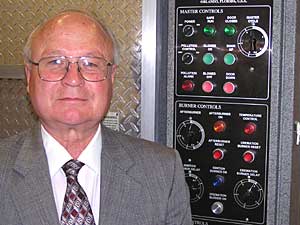|
Audio
Photos
Your Voice
|
Fargo man invents new identification program
July 5, 2004
Each year, about a half-million people are cremated. Occasionally families ask: how do we know we're getting the right ashes? Now a Fargo, North Dakota man thinks he has the answer to eliminating that doubt.
Moorhead, Minn. — Tom Shafer manages the Riverside Cemetery in Fargo. Each year he supervises dozens of cremations. Shafer says there has never been a problem with a cremation in Fargo. No bodies or remains mis-identified. But two years ago, something happened that turned Tom Shafer into an inventor.
 | |||
His motivation was an incident in Noble, Ga. Hundreds of bodies sent to a crematory ended up buried, stacked in storage sheds and discarded in a nearby woods and lake. Shafer thought there had to be a better way to track a body through the cremation process.
He tried several approaches, none of which worked. Shafer worked on his project for a year and there were challenges. Very few materials can withstand the 1800 degree heat of a cremation. He tried several things, including stainless steel. Nothing worked, until he tried clay, it's one of the few materials that hardens when exposed to extreme heat.
"It would be approximately the size of a folded billfold. Three by four inches by a half inch thick," says Shafer. "Much to my pleasant surprise, after I tried that first ceramic piece, through an entire cremation process I saw that it not only survived, but one side of it was in pretty good shape."
Shafer's system is simple, a tile, with an engraved number is placed on the body at the funeral home. The funeral director keeps a card with that number, and other important data about the body, the body is then taken to the crematory. When cremation is completed, the ashes are returned to the funeral home. The funeral director removes the identity tile from the cremated remains. The tile is checked against the paper card. Shafer says when the two numbers match, family members know the process has been completed correctly. Shafer calls his invention the Cremation Identification Assurance Tag.
 | |||
"The word assurance is key there," says Shafer. "It would demonstrate to the family, vividly, they would see the ceramic piece that is placed on the body when it leaves the funeral home. They'll see that same ceramic piece that has gone right through the cremation process with the body and has returned to the funeral home."
Shafer's invention allows for an important change in current cremation processes. For the first time, a body can be tracked, family members can watch as the identification tile is placed on the body. The tile is physical proof the family is getting the right ashes.
Shafer's invention is being well received. Steve Wright owns Wright's funeral home in Moorhead. He says the identification tile is a good idea, but he doesn't see much demand for it in smaller communities.
 | |||
Wright says that might be because all the funeral homes in the Fargo-Moorhead area are family-owned businesses. In some cases, the funeral home has been in the family for several generations. That means people know and trust each another. Wright believes there's a potential market in larger cities.
"People don't know their funeral director, number one. They certainly don't know the people who run the crematory," says Wright. "The funeral directors in those big cities often don't even see the people that run the crematory."
Tom Shafer's recieved a patent on his product. So far, the operation is still small: his production plant is in his garage. Shafer says about 20 identification tiles have sold so far. His goal isn't to get rich. Shafer just wants to make a difficult process a little easier for people.
|
News Headlines
|
Related Subjects
|

